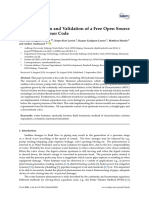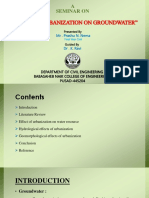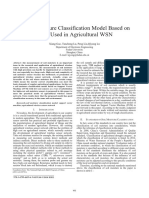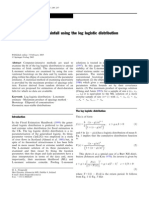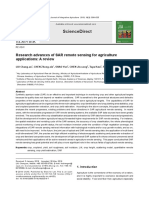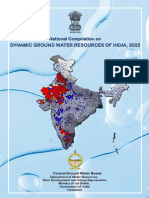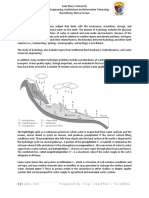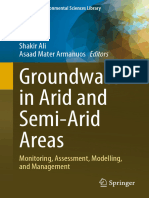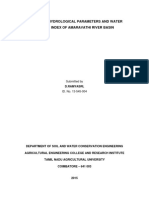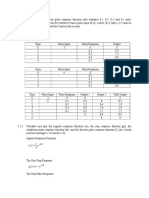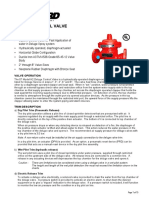USING THE CROPWAT MODEL TO ANALYSE THE EFFECTS
OF CLIMATE CHANGE ON RAINFED CROPS IN NIGER
Katiella Ma Moussa and Moustapha Amadou1
Respectively, Faculty of Sciences, University of Abdou Moumouni, BP 10662, Niamey, Niger, Tel: +227 733072, email cadres@intne.ne / kactiella@yahoo.fr ; and
Faculty of Agronomy, University of Niamey, BP 10960, Niamey, Niger, Tel: +227 733238, Fax: +227 733943, e-mail:
moustapha_a@yahoo.com / cresa@intnet.ne
�TABLE OF CONTENTS
Section
Page
Preface
Executive summary
Introduction
Background
Objectives and methodology of the study
Results and discussion
Conclusion and policy recommendations
References
10
LIST OF TABLES AND FIGURES
Table
Page
Characteristics of selected districts, Agui and Gaya
11
Length of growing period, mean yield, date of sowing and date of
harvesting and for main crops in the two selected districts, 2003
11
CROPWAT outputs for millet
12
CROPWAT outputs for cowpea
12
CROPWAT outputs for sorghum
12
A1
Cowpea Agui
13
A2
Millet Agui
13
A3
Sorghum Agui
14
A4
Millet Gaya
14
A5
Sorghum Gaya
15
A6
Cowpea Gaya
15
Variation of soil moisture deficit (SMD) according to crop and
location for reference period (19601990) and 2025
16
Figure
1
�PREFACE
The reports in this special series are the result of a multi-country research activities conducted under
the GEF funded project: Climate Change Impacts on and Adaptation of Agro-ecological Systems in
Africa. The main goal of the project was to develop multipliable analytical methods and procedures
to assess quantitatively how climate affects current agricultural systems in Africa, predict how these
systems may be affected in the future by climate change under various global warming scenarios,
and suggest what role adaptation could play. The project has been implemented in 11 countries:
Burkina Faso, Cameroon, Ghana, Niger and Senegal in west Africa; Egypt in north Africa; Ethiopia
and Kenya in east Africa and South Africa, Zambia, and Zimbabwe in southern Africa. The study
countries covered all key agro-climatic zones and farming systems in Africa. This is the first analysis
of climate impacts and adaptation in the Africa continent of such scale and the first in the world to
combine cross-country, spatially referenced survey and climatic data for conducting this type of
analysis.
The analyses reported in this series focus mainly on quantitative assessment of the economic impacts
of climate change on agriculture and the farming communities in Africa, based on both the crosssectional (Ricardian) method and crop response simulation modeling. The cross sectional analysis
also allowed for assessing the possible role of adaptation. Moreover, the project employed riverbasin hydrology modeling to generate additional climate attributes for the impact assessment and
climate scenario analyses such as surface runoff and streamflow for all districts in the study
countries.
The Centre for Environmental Economics and policy in Africa (CEEPA) of the University of
Pretoria coordinated all project activities in close collaboration with many agencies in the involved
countries, the Agriculture and Rural Development (ARD) Department of the World Bank, the World
Bank Institute (WBI), the Food and Agriculture Organization (FAO), Yale University, the
University of Colorado, and the International Water Management Institute (IWMI). The project
received supplemental funding from TFESSD, Finnish TF, NOAA-OPG, and CEEPA. We are
grateful for the invaluable contributions of all these institutions and all individuals involved in this
project. All opinions presented in this report series and any errors in it are those of the authors and
do not represent the opinion of any of the above listed agencies.
Rashid Hassan, Project Leader
CEEPA, University of Pretoria
Ariel Dinar, Project Manager
ARD, World Bank
�EXECUTIVE SUMMARY
This study used the CROPWAT model to predict the soil moisture deficit (SMD) with climate
change scenarios and assess the crop water requirement (CWR) and the variation in yield of the main
rainfed crops in Niger. Two districts, Agui and Gaya, were selected to conduct the SMD analysis in
relation to climate change under different climate and soil characteristics and cropping patterns.
Three types of data were collected and used for the selected districts. Meteorological data were
acquired from the national meteorological service. These included temperatures for 1961 to 1990,
rainfall for the same period, and evapotranspiration for the period 1978 to 1998 for Gaya and 1978 to
2002 for Agui. Soil data were supplied by INRAN (Agronomic Research Institute). Crop yields,
LGPs (length of growing period), and dates of sowing and harvesting for the selected crops (millet,
sorghum and cowpea) were provided by the National Service for Agricultural Statistics.
The MAGICC (Model for the Assessment of Greenhouse-gas Induced Climate Change) coupled to
the SCENGEN (SCEnario GENerator) software of the IPCC (Intergovernmental Panel on Climate
Change) was used to predict the impact of climate change on the soil water availability and water
uptake by crops. The HadCM2 (Hadley center unified model 2 transient, UK) GCM was selected
and the actual annual average temperature and rainfall figures for 1961 to 1990 were used as the
basic scenario. The choice of 2025 was justified by the availability of demographic projections for
Niger at this period.
The study results show a significant difference between the scenario with climate change in 2025
and without climate change for Agui in terms of soil water availability and soil moisture deficit but
this difference is not significant for Gaya where the decrease in rainfall will maintain adequate soil
moisture to support production of subsistence crops.
These findings have important implications for Nigers agricultural policy and the countrys
strategies for adapting to climate variability and change. Cropping systems may need to change as
irrigation will be required for crops that are not adapted to Sahelian conditions. Small farmers should
be helped to combine into big units (cooperatives) to increase the irrigation efficiency.
�1. Introduction
With the predicted decline in agricultural yields as a result of global warming, the pressure on
natural habitats and biological resources from agricultural practices is expected to increase. This is
of particular concern in the developing world and especially Africa, which has worse starting
conditions and limited adaptation options for African farmers and agricultural production systems.
Reduced yields will increase the demand for converting land to agricultural use, extracting water for
irrigation, introducing more new and exotic plant and animal species and intensifying the use of
chemical inputs. This pressure on the land will increase pollution and environmental damage such as
erosion, and seriously accelerate biodiversity loss and extinction.
Further warming is expected to reduce crop productivity adversely, and this will have serious
consequences because agriculture and agro-ecological systems are especially prominent in the
economies of African countries and particularly of Niger and the systems tend to be less capital and
technology intensive. It is in this context that the GEF accepted and funded the project Regional
Climate, Water and Agriculture: Impacts on and Adaptation of Agro-ecological Systems in Africa
for which Niger was selected as one of a sample of 11 African countries.
2. Background
Niger is a landlocked country in the Sahel more than 700 km from the sea, with a surface area of
1,267,000 km2 and a population of about 10 million. The climate is typically Sahelian, with two
seasons: a long dry season of eight months and a short rainy season of four months which usually
starts in May or June. The rainfall is low, variable and undependable. The cropping area is limited to
the area with a length of growing period (LGP) of 75 to 150 days, which is classified as semi-arid.
The semi-arid part of Niger is a region that faces very serious challenges for developing crop
production. Cultivating crops and keeping livestock are the most important activities in the rural
zone, practiced by 90% of the total population. But harsh environmental conditions high
temperature, low rainfall and low soil fertility and pests and diseases restrict the range of crops
grown. In general, technology based agriculture has not come to Niger on a significant scale
(ICRISAT/FAO 1996). Most of the agricultural growth that has occurred is due to the prevalence of
extensive farming systems, not yield increases. Low rainfall as a result of climate change, land
depletion, the very low level of external input, very little investment in irrigated agriculture, and the
lack of adaptive rural credit schemes constitute the major constraints on crop production in the
Sudano-Sahelian zone of Niger.
At the agro-ecological level, two main production systems can be distinguished as a function of LGP
and rainfall:
Rainfed mixed agro-pastoral system
This is the system used in the Sahelian zone. It is characterized by a short rainy season with a rainfall
lower than 600mm and an LGP of 60 to 100 days. Grains grown here are predominantly earlymaturing varieties. The major constraints on this system are high temperature, uneven rainfall
distribution and low soil fertility.
�Rainfed mixed cropping system
This is the system used in the northern Sudan savanna zone. It is characterized by an intermediate
rainy season with 600 to 800mm of rainfall, and an LGP of 100 to 125 days. Medium to latematuring varieties of crops are grown for a dual purpose (grains and fodder). The major constraints
on this system are low soil fertility and high pest and disease occurrence.
At the regional level, three main typical production systems can be distinguished as a function of
LGP, rainfall and soil types: the extensive millet-based system (EMBS), the semi-intensive milletbased system (SIMBS) and the sorghum/millet-based system (SMBS).
At the district level, apart from the irrigated systems that are found along the rivers and streams
throughout the country, seven main production systems can be distinguished. Five of them belong to
the millet based system, and two to the sorghum/millet-based system.
3. Objectives and methodology of the study
The objective of the study was to use the CROPWAT model (FAO 1979, 1998) to predict the soil
moisture deficit (SMD) with climate change scenario and assess the crop water requirement (CWR)
and the variation in yield of the main rainfed crops in Niger.
3.1 Soil moisture deficit and climate change scenario
Two districts, Agui and Gaya, were selected to assess the degree of SMD caused by climate
change. Climate and soil characteristics, including other farming and cropping patterns, are
summarized in Tables 1 and 2.
Three types of data were collected and used for the selected districts. Meteorological data were
acquired from the national meteorological service. These included temperatures for 1961 to 1990,
rainfall for the same period and evapotranspiration for the period 1978 to 1998 for Gaya and 1978 to
2002 for Agui. Soil data were supplied by INRAN (Agronomic Research Institute). Crop yields,
LGPs, dates of sowing and harvesting for the selected crops (millet, sorghum and cowpea) were
provided by the National Service for Agricultural Statistics.
The MAGICC (Model for the Assessment of Greenhouse-gas Induced Climate Change) coupled to
the SCENGEN (SCEnario GENerator) software set up by the IPCC (Intergovernmental Panel on
Climate Change) during the second appraisal report (Houghton et al. 2001) was used in this study to
predict the impact of climate change on the soil water availability and water uptake by crops. The
HadCM2 (Hadley center unified model 2 transient, UK) GCM was selected and the actual annual
average temperature and rainfall figures for 1961 to 1990 were used as the basic scenario and IS92A
(reference scenario) to generate temperature and rainfall figures for 2025. The choice of 2025 was
justified by the availability of demographic projections for Niger at this period. The countrys oldest
meteorological stations in the MAGICC/SCENGEN square degrees were identified and selected in
order to use the serial climate data available since 1960.
At this step of its development, the MAGICC/SCENGEN can only give temperature and rainfall for
2025 for most of the African regions. The temperature and rainfall generated by the model for Agui
(125'
N175'
N and 25'
75'
E) and Gaya (75'
125'
N and 25'
75'
E) were recorded. The
evapotranspiration for 2025 was obtained by using the PENMAN-Monteith method2 with the
2
http://www.fao.org/docrep/X0490E/x0490e06.htm
�temperatures for the corresponding period. The other required parameters for 2025 were used as
defined in the CROPWAT model. The yields of the main crops, the rainfall and the LGPs were
considered.
3.2 Crop water requirement and yield of main rainfed crop
Districts with meteorological stations since 1960 (Birni NKonni, Gaya, Main Soroa, Agui,
Tahoua, Tillabery and Mirriah) were selected to conduct the CWR study. Except for the Gaya
district, all the districts have LGPs, T (temperature), rainfall, ETo (evapotranspiration) and soil
characteristics similar to those of Agui. The same dates of sowing and harvesting were used for
each crop for all the districts. The growth cycle for each crop is longer in the Gaya district, as shown
in Table 2. The total cropped areas for each crop, and maximum/actual crop yields (millet, sorghum
and cowpea) for each district were provided by the National Service for Agricultural Statistics. The
Ky (yield reduction) factor from the FAO (Food and Agriculture Organization) was used for each.
Among the CROPWAT model outputs, the CWR, ETc (crop evapotranspiration), and Ks (stress
factor) were used for crop yield analysis.
4. Results and discussion
4.1 Effect of climate change on the soil moisture deficit in two different districts
The MAGICC/SCENGEN outputs predict that in 2025 the amount of rainfall will decrease and
temperature will increase in both Agui and Gaya. The CROPWAT outputs such as TAM Lost(mm),
RAM User(mm), Total Rain(mm), Efct.Rain(mm), Etc(mm), Etc/Etm (%) and considered as crop
yield parameters are shown in Tables A1 to A5 for the three selected crops and locations. The SMD
variation for each crop and location, with and without climate change, are shown in Figure 1.
The trends of SMD are the same for both the reference period and 2025 but different in Agui and
Gaya. Figure 1 shows that the trend of the SMD is more critical at Agui than at Gaya for both the
reference period and for 2025. For all the selected crops, the SMD will be increased in 2025. The
SMD is almost the same for the two scenarios during the first crop growth stage and does not exceed
the evapotranspiration. The SMD decreases drastically during the vegetative phase and maturity. The
CROPWAT analysis also shows that there is a significant decrease in crop yield for all crops and
locations. This decrease is more significant at Agui which will have less rainfall in 2025. In Gaya
the decrease in the millet yield is not significant as there will be enough rainfall to maintain soil
moisture during the crops maturity.
These results seem to match the climate change scenario as predicted in the literature, but further
discussion is needed to bring them in line with the projects objectives and needs.
4.2. Effect of crop water requirements on the yield of the main rainfed crops
4.2.1 Crop water use for millet (Table 3)
Millet is the most common rainfed crop in Niger and the subsistence nature of the crop is well
documented. Millet farming suits almost all the studied districts. The highest value of ETo was
7
�observed in the Tahoua district with 741mm. This district is in fact located in the central northern
part of the country at the limit of the Sahara Desert and characterized by a high diurnal temperature
during the rainy season. Main Soroa, located in the eastern part of the country, shows the highest
Etc owing to the high evaporation demand linked to a high temperature and a low hygrometry. There
is some variation in CWR between districts, given that millet is a crop which does not need a lot of
water and the most commonly cultivated variety has a short cycle in all the districts except Gaya,
where varieties with a long cycle are used. The maximum yields were obtained in Gaya (815kg/ha),
where the annual average rainfall is 800mm, and Agui (757 kg/ha), where cropping systems are
more intensive, with higher inputs.
4.2.2 Crop water use for cowpea (Table 4)
The ETo of the cowpea growing period was above 400mm in all the districts. Tahoua and Main
Soroa have the highest rates, with 816 and 747 mm/period respectively. The CWR is almost the
same for all the districts, around 200mm and 300mm, except for Tahoua (325mm). The response
coefficients due to water stress are low everywhere except in Tahoua (0.96) and Mirriah (0.89). This
is explained by a poor rainfall distribution in time (during the various growth phases of the crop) that
caused a critical drying up of the soils usable moisture. Thus the yield reduction can be considered
significant or not at harvest according to the phase when the SMD has been critical.
4.2.3 Crop water use for sorghum (Table 5)
Sorghum being a water demanding crop, only the area of Gaya that has favorable meteorological and
edaphic conditions presents a optimal yield. Here, the need for crop water is almost entirely satisfied
(CWR is 46mm for the whole cycle). In fact, the rainy season covers the sorghum cycle and the
clayey-sandy and clayey-loamy soil has a fairly good retention capacity. The areas of Tillabery,
Konni and to some extent Agui have favorable valleys and alluvial plains where sorghum is farmed,
but the high evaporation demand (ETo above 500 mm) increases the evapotranspiration of the crop
and therefore the demand for water. The additional water CWRs of the sorghum for the areas
mentioned above are 114mm, 154mm, 121mm respectively. This water deficit thus can be seen to
affect the yield: only 363kg/ha in Tillabery, 351kg/ha in B. Konni and 190kg/ha in Aigu. The very
low yield in Agui is explained by the type of soil, which is subject to overcropping.
5. Conclusion and policy recommendations
The major crops covered in this report are cultivated in mixed cropping systems in all the districts
studied. This mixture of crops allows us to forecast the risks related to the amount and timing of the
rainfall during the cropping season as all these selected crops are exclusively cultivated during the
rainy season. There is no chance for irrigation, even if the rainfall deficit is critical, as farmers
cannot afford the required input. In all the districts the fertile areas in the field are allocated to cash
crops such as okra, tobacco, sesame, galingale (an aromatic ginger-like root used for medicine) and
maize. These cropping systems are common and known at national level as a confirmed strategy for
adapting to climate variability and change.
According to the above, the CROPWAT model is applicable in Niger country conditions even if
irrigation is not common, with less than 60,000ha being used for irrigated agriculture.
The study results show a significant difference between the scenario with climate change (2025) and
without climate change for Agui in terms of soil water availability and soil moisture deficit but this
8
�difference is not significant for Gaya where the decrease in rainfall with this scenario (2025) will
maintain adequate soil water availability for producing subsistence crops. For all these districts,
except Gaya, there is little chance of irrigation for subsistence crops in the future.
These findings may have important implications for Nigers agricultural policy. Based on these
intermediate conclusions, the following recommendations can be made:
1. Strategies for adapting to climate variability and change should be formulated and adopted at
community, district and national level
2. Cropping systems should be improved by changing to irrigation for crops that are not adapted to
Sahelian conditions.
3. Small farmers should be helped to combine into big units (cooperatives) to increase the irrigation
efficiency.
4. Water resource management should be recognized as the main constraint on crop productivity in
the country and steps taken to improve it.
�REFERENCES
FAO (Food and Agriculture Organization), 1979. Yield response to water. Authors, Doorenbos J &
Kassam AH. Irrigation and Drainage Paper 33. Rome, Italy.
FAO (Food and Agriculture Organization), 1998. Crop evapotranspiration : Guidelines for
computing crop water requirements. Authors, Allen RG, Pereira LS, Raes D & Smith M.
Irrigation and Drainage Paper 56. Rome, Italy.
Houghton JT et al., (eds), 2001. Climate Change 2001: The Scientific Basis. Contribution of
Working Group I to the third assessment report of the Intergovernmental Panel on Climate
Change. Cambridge: Cambridge University Press.
ICRISAT/FAO (International Crop Research Institute for Semi-Arid Tropics / Food and Agriculture
Organization), 1996. The world sorghum and millet economies: Facts, trends and outlook.
FAO, Rome, and ICRISAT, Patancheru, India.
10
�Table 1: Characteristics of selected districts, Agui and Gaya
Agui
Gaya
Geographical area
Sahelian zone
Sudan savanna zone
Type of system
Short season SAT, rainfed mixed
agro-pastoral
Intermediate season SAT, rainfed
mixed cropping
Length of growing period (days)
60100
100125
Soil (Hcr %)
Sandy (9)
Loamy (22)
Rainfall (mm)
< 600
600800
Based system
Semi-intensive millet-based system
(SIMBS)
Sorghum/Millet-based system
(SMBS)
Main crops
Millet, sorghum, cowpea,
groundnut
Sorghum, millet, cowpea,
groundnut
Intensity of crop PS
Lowmedium
Low
Cash crops
Reasonable
Limited/Reasonable
Role of trees
Fertility management
Fruit, firewood
Role of livestock
Manure, transport, animal traction
Corralling, transport
Major constraints
Rainfall, high temperature, soil
fertility
Soil fertility
Livestock shortage in farming
systems, priority for crop
production without any specific
pasture area
Sub Systems
Reduction of fallow, pest and
disease management
Millet-cowpea-sorghum-groundnut
low external input
Sorghum-millet-cowpea-groundnut
Table 2: Length of growing period, mean yield, date of sowing and date of harvesting and for
main crops in the two selected districts, 2003
Gaya
Agui
Cycle (days)
Yield (kg/ha)
Cycle (days)
Yield (kg/ha)
Millet
120
Sorghum
140
604
90
401
596
105
185
Cowpeas
120
124
100
108
Date of sowing
Date of harvesting
Gaya
Agui
Gaya
Agui
Millet
10 May
15 June
10 Sept
15 Sept
Sorghum
30 May
30 June
20 Oct
15 Oct
Cowpeas
30 May
30 June
20 Oct
10 Oct
11
�Table 3: CROPWAT outputs for millet
District
ETo
Kc
mm
B. Konni
581
ETc
Ky
mm
1.00
380
Ya
Ym
Area cropping
kg/ha
kg/ha
intensity, %
502
543
45
1.20
Ks
0.94
Eta
CWR
mm
mm
356
196
Gaya
451
1.00
305
1.20
746
851
50
0.90
275
153
Main S.
682
1.00
440
1.20
372
524
71
0.76
334
232
Agui
536
1.00
363
1.20
483
757
51
0.70
254
181
Tahoua
741
1.00
416
1.20
298
312
53
0.96
399
251
Tillabery
636
1.00
432
1.20
412
428
60
0.97
419
216
Mirriah
597
1.00
405
1.20
408
461
55
0.90
365
203
Notes: ETo (reference crop evapotranspiration), ETc (evapotranspiration of the crop), Ky (yield reduction factor), Ya
(actual yield of the crop), Ym (maximum yield of the crop), Ks (stress factor), CWR (crop water requirement), ETa
(actual evapotranspiration).
Table 4: CROPWAT outputs for cowpea
District
ETo
Kc
mm
B. Konni
633
ETc
Ky
Ya
Ym
Area cropping
kg/ha
kg/ha
intensity, %
1.15
142
314
36
mm
1.15
502
Ks
Eta
mm
0.52
261
CWR
mm
251
Gaya
497
1.15
396
1.15
171
317
30
0.60
240
198
Main S.
747
1.15
452
1.15
51
87
13
0.64
289
298
Agui
581
1.15
461
1.15
134
304
23
0.51
237
231
Tahoua
816
1.15
427
1.15
122
189
32
0.69
294
325
Tillabery
697
1.15
496
1.15
207
216
28
0.96
476
278
Mirriah
650
1.15
494
1.15
189
216
29
0.89
440
258
Ks
Eta
CWR
mm
Table 5: CROPWAT outputs for sorghum
District
ETo
Kc
mm
ETc
Ky
mm
Ya
Ym
Area cropping
kg/ha
kg/ha
intensity, %
mm
B. Konni
650
1.00
450
1,25
351
385
18
0.93
418
154
Gaya
519
1.00
362
1,25
676
800
15
0.88
317
46
Main S.
771
1.00
473
1,25
111
160
10
0.76
357
280
Agui
592
1.00
408
1,25
190
309
10
0.69
282
121
Tahoua
832
1.00
486
1,25
275
276
11
1.00
486
321
Tillabery
697
1.00
492
1,25
363
409
10
0.91
448
114
Mirriah
666
1.00
456
1,25
198
248
12
0.84
383
195
12
�APPENDICES
Table A1: Cowpea Agui
Date
30/6
4/7
14/7
24/7
3/8
13/8
23/8
2/9
12/9
22/9
2/10
12/10
Total
TAM lost
(mm)
Rf.
2025
30
30
35.6
35.6
49.6
49.6
63.6
63.6
77.6
77.6
91.6
91.6
100
100
100
100
100
100
100
100
10
100
100
RAM user
(mm)
Rf. 2025
13.5 13.5
16
16
22.3 22.3
28.6 28.6
34.9 34.9
41.2 41.2
45
45
45
45
45
45
45
45
48.8 48.8
56.3
Total rain
(mm)/dcd
Rf. 2025
00
00
55.4 42.7
62.1 51.2
68.1 57.3
72.3 59.5
73.9 57.2
71.7 49.9
64.9 38.3
53.5 24.2
38.1 10.6
20.5 1.4
4.6
585 392.3
Efct. rain
(mm)/dcd
Rf. 2025
00
00
7.5
8.1
24.4 26.1
25.4 27
37.3 39
40
40
40
40
40
38.3
40
24.2
38.1 10.6
20.5 1.4
4.6
318 254.8
Etc
(mm)/dcd
Rf. 2025
2.5
2.7
2.5
2.7
2.4
2.6
3.1
3.3
4.5
4.7
5.8
6
6.4
6.5
6.3
6.4
6.2
4.8
6.1
2.6
3.8
0.9
1.4
406 355
Etc/Etm
(%)
Rf. 2025
100 100
100 100
99.9 99.2
100 100
100 99.9
99
98.4
92.2 90.4
78.4 75.9
69.7 63.7
66.5 43.6
62.4 24
52.4
79.4 67.6
SMD
(mm)
Rf.
2.5
2.5
2.4
3.1
4.5
16.1
34.1
43.6
47
49.8
65.3
80.8
Etc
(mm)/dcd
rf
2025
1.9
2.1
1.9
2.1
1.9
2
3.2
3.4
4.5
4.8
5.8
6
5.7
5.8
5.5
5.7
5.5
5.5
5.4
5
5.3
2.6
3.9
0.7
1.4
454.4
Etc/Etm
(%)
rf
2025
100 100
100 100
100 100
100 100
100 100
100 100
99.4 97.8
91.1 86.7
81.7 77.7
76.9 71.6
75.4 47.9
77.5 26.3
61
85.3
SMD
2025
2.7
2.7
2.6
3.3
4.7
17.8
36.3
4
62.9
79.4
92.2
Table A2: Millet Agui
Date
15/6
24/6
4/7
14/7
24/7
3/8
13/8
23/8
2/9
12/9
22/9
2/10
12/10
Total
TAM lost
(mm)
Rf
2025
30
30
46.2
46.2
64.2
64.2
82.2
82.2
100
100
100
100
100
100
100
100
100
100
100
100
100
100
100
100
100
100
RAM user
(mm)
Rf
2025
15
15
23.9 23.9
34.5 34.5
45.9 45.9
57.8 57.8
59.8 59.8
60
60
60
60
60
60
60
60
60
60
63.3 63.3
66.7
Total rain
(mm)/dcd
rf
2025
00
00
48.6 33.1
55.4 42.7
62.1 51.2
68.1 57.3
72.3 59.5
73.9 57.2
71.7 49.9
64.9 38.3
53.5 24.2
38.1 10.6
20.5 1.4
4.6
633.7
Efct. rain
(mm)/dcd
rf
2025
00
00
15.3 16.9
18.8 20.5
24.8 26.6
38.2 40
40
40
40
40
40
40
40
38.3
40
24.2
38.1 10.6
20.5 1.4
4.6
360.2
13
rf
1.9
1.9
1.9
3.2
4.5
16.7
33.5
44.5
49.4
51
53.2
68.4
84.3
2025
2.1
2.1
2
3.4
5.3
20
37.9
47.7
52.9
68
83.3
94.2
�Table A3: Sorghum Agui
Date
30/6
4/7
14/7
24/7
3/8
13/8
23/8
2/9
12/9
22/9
2/10
12/10
Total
TAM
lost(mm)
Rf
2025
30
30
38
38
58
58
78
78
98
98
100 100
100 100
100 100
100 100
100 100
100 100
100
RAM
user(mm)
Rf
2025
18
18
22.5 22.5
33.3 33.3
43.4 43.4
52.7 52.7
52
52
50
50
50
50
50
50
50
50
50
50
60
Total rain
(mm)/dcd
Rf
2025
00
00
55.4 42.7
62.1 51.2
68.1 57.3
72.3 59.5
73.9 57.2
71.7 49.9
64.9 38.3
53.5 24.2
38.1 10.6
20.5 1.4
4.6
585 392
Efct. rain
(mm)/dcd
rf
2025
00
00
5.6
6.1
18.4 19.8
19.1 20.3
28.6 30
39.5 40
40
40
40
38.3
40
24.2
38.1 10.6
20.5 1.4
4.6
294 231
Etc
(mm)/dcd
rf
2025
1.9
2
1.9
2
1.8
1.9
2.4
2.5
3.5
3.6
4.5
4.7
5.5
5.7
5.5
5.5
5.4
5.4
5.3
2.8
4.4
1.1
2
395 333
Etc/Etm
(%)
rf
2025
100 100
100 100
100 100
100 100
100 100
100 100
100 100
97.4 95.9
89.7 85.7
82.8 57.3
75.2 29.9
53.5
78.2 64.1
SMD
(mm)
rf
1.9
1.9
1.8
2.4
3.5
4.5
15.4
29
37.5
43.7
62.9
84.2
2025
2
2
1.9
2.5
3.6
5.6
17.9
33.3
56.2
76.6
91.2
Table A4: Millet Gaya
Date
10/5
15/5
25/5
4/6
14/6
24/6
4/7
14/7
24/7
3/8
13/8
23/8
2/9
12/9
Total
TAM lost
(mm)
Rf
2025
42
42
54.6 54.6
79.8 79.8
105 105
130 130
140 140
140 140
140 140
140 140
140 140
140 140
140 140
140 140
140 140
RAM user
(mm)
Rf
2025
21
21
27.8 27.8
42.3 42.3
57.8 57.8
74.2 74.2
82.6 82.6
84
84
84
84
84
84
84
84
84
84
86.8 86.8
91.5 91.5
96.1 96.1
Total rain
(mm)dcd
rf
2025
00
00
26.1 25.4
31.5 30.9
36.8 36.4
42.3 42.2
48.3 48.6
54.6 55.4
60.8 62.1
66.4 68.1
70.4 72.3
71.8 73.9
69.5 71.7
62.8 64.9
51.6 53.5
693 705
Efct. rain
(mm)dcd
rf
2025
00
00
7.7
7.7
18.9 18.7
20.2 19.8
31.6 30.5
40
40
40
40
40
40
40
40
40
40
40
40
40
40
40
40
40
40
438 437
14
Etc
(mm)/dcd
rf 2025
2
2
1.9 1.9
1.8 1.8
2.6 2.5
3.8 3.7
4.9 4.7
5.2 5
5
4.8
4.9 4.6
4.7 4.5
4.6 4.5
3.9 3.9
2.8 2.8
1.8 1.8
479 465
Etc/Etm
(%)
rf
2025
100 100
100 100
100 100
100 100
100 100
100 100
100 100
100 100
100 100
100 100
99.6 100
99.2 100
100 100
100 100
99.9 100
SMD
(mm)
Rf
6.2
1.9
1.8
2.6
3.8
8.3
20.8
32
41.2
48.9
55.1
58
50.8
33
2025
6.2
1.9
1.8
2.5
3.7
6.1
15.9
24.4
31.3
37
42
44.7
37.
20.5
�Table A5: Sorghum Gaya
Date
30/5
4/6
14/6
24/6
4/7
14/7
24/7
3/8
13/8
23/8
2/9
12/9
22/9
Total
TAM lost
(mm)
Rf
2025
54
54
72
72
108 108
144 144
180 180
180 180
180 180
180 180
180 180
180 180
180 180
180 180
180 180
RAM user
(mm)
Rf
2025
32.4 32.4
42.5 42.5
61.9 61.9
79.9 79.9
96.5 96.5
93.3 93.3
90
90
90
90
90
90
90
90
91.8 91.8
110 110
128 128
Total rain
(mm)/dcd
rf
2025
00
00
36.8 36.4
42.3 42.2
48.3 48.6
54.6 55.4
60.8 62.1
66.4 68.1
70.4 72.3
71.8 73.9
69.5 71.7
62.8 64.9
51.6 53.3
36.5 38.1
672 687
Efct. rain
(mm)/dcd
rf
2025
00
00
7.2
7
17.4 16.8
18.4 17.5
27.2 25.9
36.4 34.5
40
40
40
40
40
40
40
40
40
40
40
40
36.5 38.1
383 380
Etc
(mm)/dcd
rf
2025
1.8
1.8
1.8
1.7
1.7
1.6
2.3
2.2
3.2
3.1
4.1
3.9
4.9
4.6
4.7
4.5
4.6
4.5
4.5
4.5
4.4
4.5
3.7
3.9
3.1
3.3
441 435
Etc/Etm
(%)
rf
2025
100 100
100 100
100 100
100 100
100 100
100 100
100 100
100 100
100 100
100 100
100 100
100 100
100 100
100 100
SMD
(mm)
rf
7.2
1.8
1.7
2.3
3.2
4.1
9.8
17.5
23.9
29.3
34.1
34.3
31.4
Etc/Etm
(%)
rf
2025
100 100
100 100
100 100
100 100
100 100
100 100
100 100
98.4 99.8
93.3 96.9
87.7 92.1
85.8 89.5
98.3 99.2
96
97.5
SMD
2025
7.2
1.7
1.6
2.2
3.1
3.9
7.4
13.1
18.2
23
28.1
29.4
26.6
Table A6: Cowpea Gaya
Date
30/5
4/6
14/6
24/6
4/7
14/7
24/7
3/8
13/8
23/8
2/9
12/9
Total
TAM lost
(mm)
Rf
2025
42
42
51.8 51.8
71.4 71.4
91
91
111 111
130 130
140 140
140 140
140 140
140 140
140 140
140 140
RAM user
(mm)
Rf
2025
18.9 18.9
23.3 23.3
32.1 32.1
41
41
49.8 49.8
58.6 58.6
63
63
63
63
63
63
63
63
69.3 69.3
79.8 79.8
Total rain
(mm)/dcd
rf
2025
00
00
36.8 36.4
42.3 42.2
48.3 48.6
54.6 55.4
60.8 62.1
66.4 68.1
70.4 72.3
71.8 73.9
69.5 71.7
62.8 64.9
51.6 53.5
635 649
Efct. rain
(mm)/dcd
rf
2025
00
00
9.6
9.3
23.2 22.4
24.4 23.3
35.4 33.6
40
40
40
40
40
40
40
40
40
40
40
40
40
40
373 369
15
Etc
(mm)/dcd
rf
2025
2.4
2.4
2.4
2.3
2.3
2.2
3
2.9
4.2
4
5.3
5
5.6
5.3
5.4
5.2
5.3
5.2
5.2
5.2
4.1
4.1
2.3
2.4
431 426
rf
6.6
2.4
2.3
3
4.2
12.1
28.1
42
51.8
57.6
58.6
48.8
2025
6.6
2.3
2.2
2.9
4
9.4
22.6
35
45.2
52.7
55.8
47.1
�Figure 1: Variation of soil moisture deficit (SMD) according to crop and location for reference
period (19601990) and 2025
Millet Gaya
Millet Agui
SMD (mm)
100
80
60
40
20
0
1 2 3 4 5 6 7 8 9 10 11 12 13
13
11
SMD (mm)
80
60
40
20
0
Decades
Decades
Cowpea Gaya
Cowpea Agui
SMD (mm)
SMD (mm)
80
60
40
20
100
50
0
1 2
0
1 2 3 4 5 6 7 8 9 10 11 12
Decades
SMD (mm)
SMD (mm)
30
20
10
7 8
9 10 11 12
Sorghum Agui
P.ref
40
Decades
H2025
Sorghum Gaya
3 4
100
80
60
40
20
0
1 2 3 4 5 6 7 8 9 10 11 12
11
13
Decades
Decades
16


